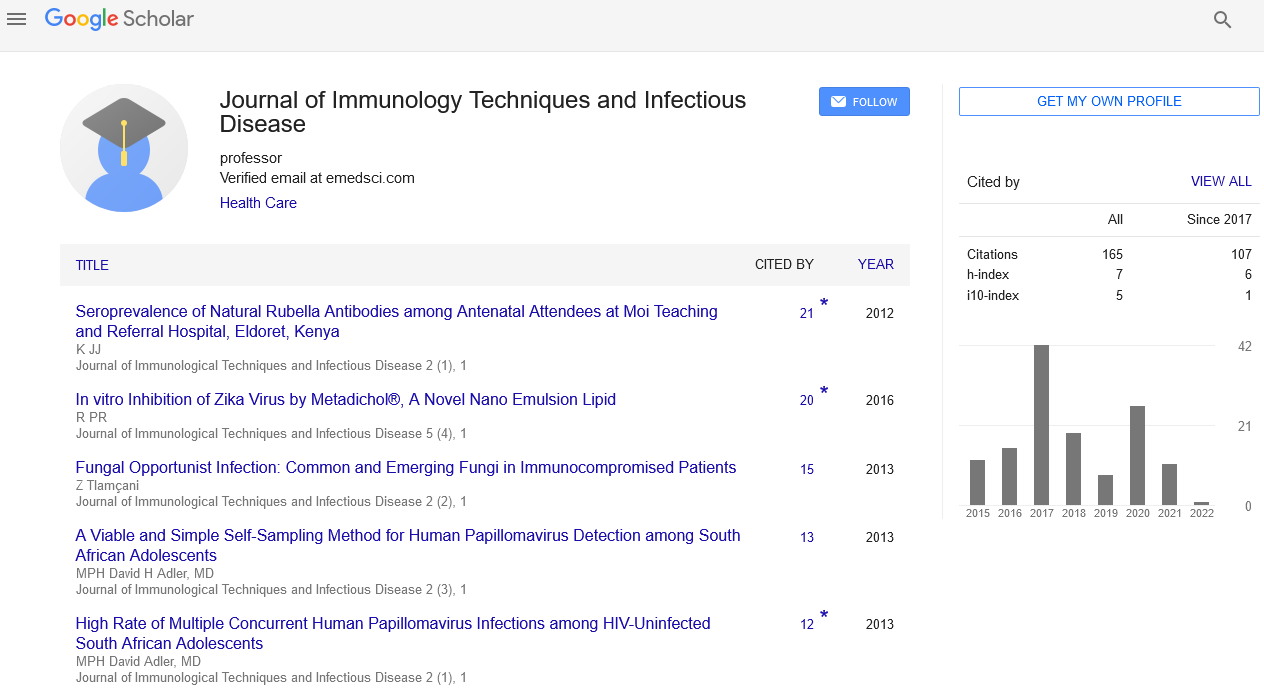Perspective, J Immunol Tech Infect Dis Vol: 12 Issue: 2
Novel Antiviral Approaches for Viral Hemorrhagic Fever Treatment and Control
Jami Krause*
1Department of Epidemiology of Microbial Diseases, Yale School of Public Health, New Haven, USA
*Corresponding Author: Jami Krause,
Department of Epidemiology of
Microbial Diseases, Yale School of Public Health, New Haven, USA
E-mail: jamikrause11@gmail.com
Received date: 29 May, 2023, Manuscript No. JIDIT-23-105429;
Editor assigned date: 31 May, 2023, PreQC No. JIDIT-23-105429 (PQ);
Reviewed date: 14 June, 2023, QC No. JIDIT-23-105429;
Revised date: 21 June, 2023, Manuscript No. JIDIT-23-105429 (R);
Published date: 28 June, 2023, DOI: 10.4172/2329-9541.1000342.
Citation: Krause J (2023) Novel Antiviral Approaches for Viral Hemorrhagic Fever Treatment and Control. J Immunol Tech Infect Dis 12:2.
Description
Viral Hemorrhagic Fever (VHF) is a group of life-threatening illnesses caused by a variety of viruses. These diseases, characterized by high fever and bleeding disorders, have garnered significant attention due to their potential for rapid spread and high mortality rates. The outbreaks of Ebola, Marburg, Lassa fever, and other VHFs have repeatedly reminded us of the urgent need for effective prevention, surveillance, and treatment strategies. Exploring VHF’s their origins, transmission, clinical manifestations, and the ongoing efforts to combat these deadly diseases.
Viral Hemorrhagic Fevers encompass several distinct diseases caused by different families of viruses. The most infamous VHFs include Ebola virus disease, Marburg virus disease, Lassa fever, Crimean-Congo hemorrhagic fever, and Hantavirus pulmonary syndrome. Each virus belongs to a specific family and exhibits unique characteristics. These viruses are primarily zoonotic, meaning they originate in animals and can be transmitted to humans through direct contact, inhalation of infected aerosols, or ingestion of contaminated food. VHFs can spread through various modes of transmission, depending on the specific virus. Direct contact with infected bodily fluids, such as blood, saliva, or vomit, is a common route of transmission. Aerosol transmission is a significant concern in certain VHFs, as tiny particles containing the virus can be inhaled , leading to infection. Some viruses, like the Hantavirus, can be transmitted through contact with infected rodents or their droppings. Understanding the transmission routes is important for implementing effective control measures and preventing outbreaks.
The clinical manifestations of VHFs vary, but common symptoms include high fever, fatigue, muscle aches, headache, and bleeding disorders. As the diseases progress, patients may experience gastrointestinal symptoms, respiratory distress, and organ failure. Early diagnosis of VHFs is challenging due to the similarity of symptoms with other infectious diseases. However, rapid diagnostic tests, including Polymerase Chain Reaction (PCR) and serological assays, have improved the ability to identify specific viral infections accurately. Preventing and controlling VHFs require a multifaceted approach. Strict infection control measures, including Personal Protective Equipment (PPE), isolation of patients, and proper disposal of infectious materials, are vital. Public health education plays a crucial role in promoting awareness and teaching preventive measures, such as regular hand hygiene and avoiding contact with infected individuals or animals. Development of effective vaccines and antiviral drugs is a difficult area of study for VHF control, although currently, specific treatments remain limited. In recent years, the international community has recognized the need to strengthen global preparedness and response to VHF outbreaks. National and international agencies have established surveillance systems to detect and respond to outbreaks promptly. Collaborative efforts among researchers, healthcare professionals, and policymakers have contributed to improved diagnostics, vaccine development, and treatment strategies. However, challenges remain, such as inadequate healthcare infrastructure in affected regions, ongoing surveillance and research gaps, and the potential for emerging VHFs.
Conclusion
Viral Hemorrhagic Fevers continue to pose a significant threat to global health security. The outbreaks of diseases like Ebola and Lassa fever have highlighted the devastating impact of these infections on individuals, communities, and healthcare systems. To combat VHFs effectively, ongoing investment in research, infrastructure, and international collaboration is essential. Only through these collective efforts can we hope to prevent future outbreaks, mitigate the impact of existing ones, and protect the lives of those at risk from these deadly diseases.
 Spanish
Spanish  Chinese
Chinese  Russian
Russian  German
German  French
French  Japanese
Japanese  Portuguese
Portuguese  Hindi
Hindi 
